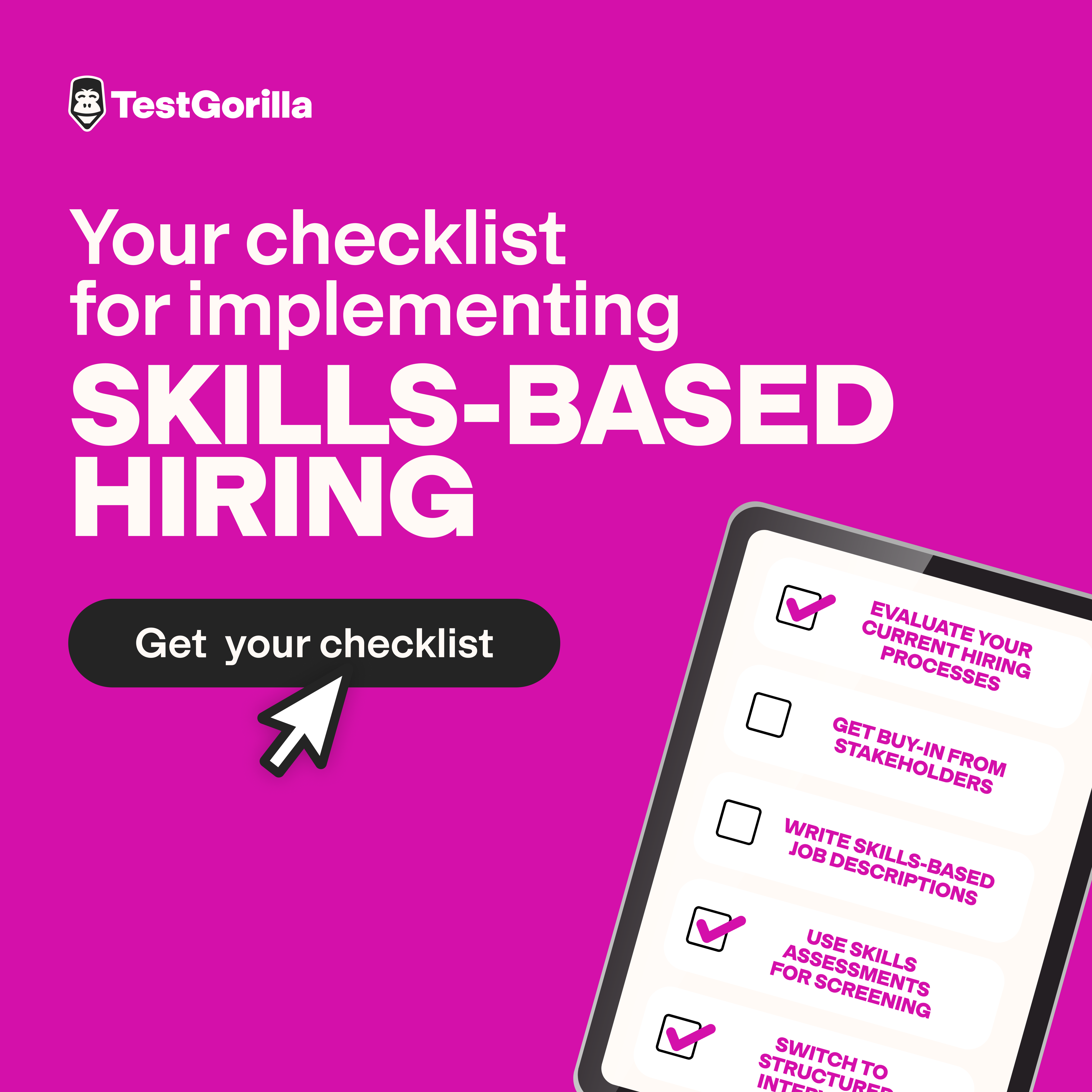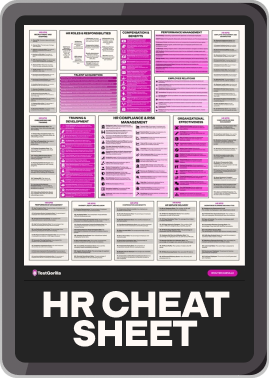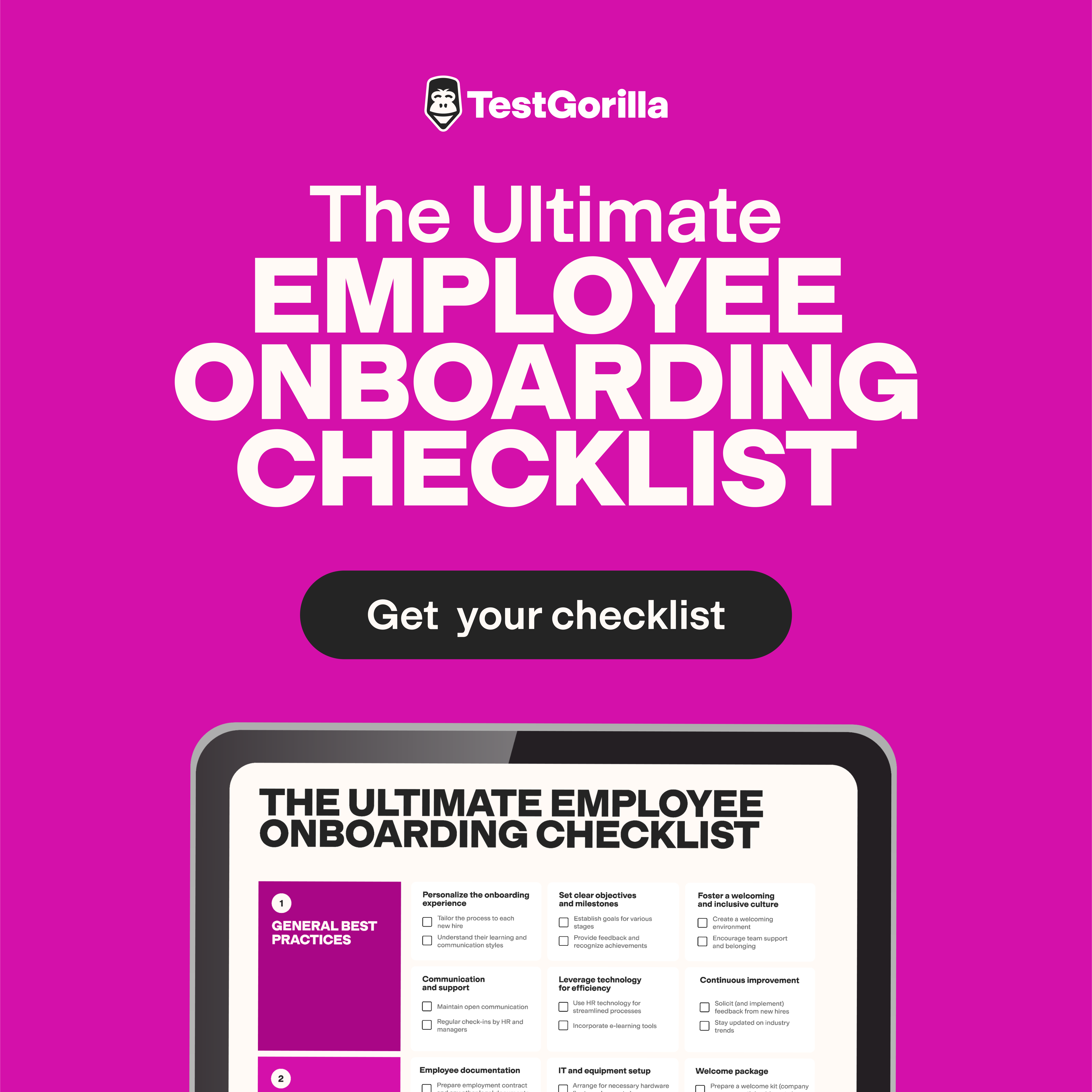What is B1 language proficiency? Hiring intermediate role candidates
Evaluating candidates' language proficiency against the Common European Framework of Reference for Languages (CEFR) – a language skills measurement scale – helps you avoid interviewing or hiring people who can’t communicate in the workplace language. This helps you save interviewing costs, prevent problematic miscommunications, and more.
Below, we explore what communication candidates with B1 language proficiency can handle, which jobs suit their language level, and how to use language proficiency tests to evaluate their language ability.
Table of contents
- Understanding B1 language proficiency
- The role of B1 language proficiency in hiring
- Assessing B1 language proficiency in candidates
- Integrating B1 assessments into the hiring process
- Impact of B1 proficiency on team performance and communication
- Find the ideal B1-level candidate for your role with TestGorilla
Understanding B1 language proficiency
Each of the six CEFR levels – A1, A2, B1, B2, C1, and C2 – represents a progressive stage of language ability. A1 is a low beginner level, and C2 is near-native fluent use of the language.
People with B1 proficiency are at an intermediate level. They’re early-stage independent users of the language and can communicate for some professional purposes. They can:
Give and ask for personal information
Pick out specific details in clear language about familiar topics, like their work, travel, and hobbies
Understand and give descriptions of familiar items
Make notes on familiar matters like customer food orders
Deal with predictable requests
Follow uncomplicated demonstrations and presentations
Offer straightforward explanations for opinions
They’re likely to struggle with:
Understanding non-standard, fast-paced spoken language, especially in noisy environments
Speaking in depth and at length on unfamiliar or complex subjects and abstract topics
Fully grasping detailed texts and speech on unfamiliar or expert-level topics
Taking part in interactions requiring lots of spontaneity or involving complex situations
Understanding implicit meaning
The role of B1 language proficiency in hiring
When your applicants include non-native speakers, you must get a solid understanding of their proficiency in the workplace language.
Using a standardized framework like the CEFR is typically the best way to assess candidates’ language ability.
People at a B1 language level are typically limited to roles where communication – either between colleagues or with customers – isn’t a large part of daily responsibilities or where interactions are within a narrow subject area.
Positions that suit B1-level candidates include:
Hospitality roles
Retail assistants
Customer service representatives
Education support staff
Administrative assistants
When hiring for these types of roles, you must ensure your new hires can communicate clearly and confidently. They should do more than just give rote responses – they should be able to take part in more flexible interactions using wider vocabulary.
For example, a waiter in a restaurant must be able to explain dishes of the day and give information about ingredients – whereas this back-and-forth interaction isn’t as important for a busser role.
The best insights on HR and recruitment, delivered to your inbox.
Biweekly updates. No spam. Unsubscribe any time.
Assessing B1 language proficiency in candidates
Workers do much with language in the workplace – serve customers, deal with complaints, undertake training, and collaborate.
So, you should typically assess your candidates’ speaking, listening, reading, and writing skills (depending on the role).
Speaking
Speaking includes vocabulary, pronunciation, and fluency.
B1 speakers:
Can produce unrehearsed speech and keep conversations going about a familiar range of subjects, like work
Can connect chunks of shorter language into longer explanations or narratives and speak coherently
Often spend time searching for expressions, which lowers their degree of fluency
Listening
Listening involves understanding accents and connected speech.
B1 listeners:
Can understand the main point of standard speech and pick out important details
Struggle with slang and idioms
Rely on speech delivery that’s clear and slower than native-level speech
Reading
Reading includes extracting details and grasping the overall meaning.
B1 readers:
Can follow texts made up of high-frequency words on job-related topics
Are slow readers
Usually must read the text more than once to absorb everything they need
Writing
Writing requires knowledge of grammar and sentence structure.
B1 writers:
Can write straightforward letters, emails, and reports
Have a vocabulary that’s limited to high-frequency words on everyday topics
Use simple but understandable grammar and sentence structures
Traditional methods for assessing B1 language proficiency
There are several ways to assess language ability. Traditional methods include the following:
Standardized proficiency tests
Standardized proficiency tests are the best way to assess a candidate’s language ability. By assessing a range of skills, these give you a reliable indicator of test-takers’ actual language abilities.
Grammar tests
While grammar is crucial to the effective use of language, you shouldn’t use grammar tests alone. Someone can have a strong understanding of a language’s grammar but not be able to speak it or use it in interactions.
Oral language assessments
Oral language tests are face-to-face interviews with trained language assessors. They’re a thorough way to evaluate language proficiency – especially people’s ability to engage in conversation, express themselves fluently, and respond spontaneously. But they’re time-consuming, expensive, and impractical for most hiring situations.
Self-assessments
Self-assessment is inexpensive, and there are many assess-your-own-language-level tests out there. But using them to guide hiring decisions isn’t recommended. Many self-assessment tests lack the range and depth needed to give reliable results. The absence of anti-cheating measures also enables candidates to retake the test multiple times and memorize the correct answers.
Another option: TestGorilla’s language proficiency tests
Here’s what makes TestGorilla’s standardized B1 language tests great:
Created by experts: TestGorilla’s tests are created and peer-reviewed by experienced linguists and language instructors. Then, before going live, they’re rigorously tested hundreds of times. For instance, our Spanish B1 test was created by Mateo A., a test developer, linguist, ESL teacher, and translator.
Based on CEFR levels and the most important language skills: When a candidate tests at the B1 level using one of our tests, you can feel assured they have the necessary grammar, vocabulary, and comprehension skills to communicate at an intermediate level.
Objective: TestGorilla automatically calculates candidates’ results and compares them with other test-takers, allowing you to make bias-free, data-driven employment decisions.
Tailored for employment: Unlike language proficiency tests like the IELTS, which is expensive and geared toward international students, TestGorilla’s tests are tailored for hiring and far more suitable for assessing large numbers of people.
Incorporate anti-cheating measures: TestGorilla’s tests have strong, built-in anti-cheating measures to give you confidence in the results – including webcam snapshots, the inability for candidates to copy/paste, and screen monitoring.
Integrating B1 assessments into the hiring process
Here’s how to integrate a B1 language test into your hiring process:
1. Make sure your role truly requires B1 proficiency
Assess the position and identify which level of language proficiency is needed to fulfill it.
Consider these questions:
Will the successful candidate have direct exchanges with customers?
Are most workplace exchanges regular interactions on routine matters?
Will most language they have to produce be well-structured and follow typical patterns?
Will they usually be able to rely on a few basic phrases?
If you answer “yes” to these questions, it’s likely the role needs B1 language proficiency.
2. Clearly state the B1 language requirement
Include the B1 language requirement prominently in the job description (for instance, in the required skills) so you don’t get flooded with applications from candidates who don’t meet this level.
3. Assess language proficiency early in the hiring process
Test your candidates for B1 proficiency as soon as possible. This avoids situations like getting to the interview stage and realizing that a candidate can’t hold a conversation in the working language. Consider using TestGorilla, which enables you to screen all your applicants using B1 language tests (like our B1 English test).
4. Build the language proficiency test into a comprehensive assessment
TestGorilla makes it easy to combine a B1 language test with up to four other job-related tests, such as the Hospitality test. This enables you to create customized assessments that evaluate candidates for all the skills they need for your role.
Impact of B1 proficiency on team performance and communication
According to Grammarly’s 2024 State of Business Communication report, all aspects of communication are increasing – interactions are more frequent, and they’re happening over more channels. But the same report reveals that poor communication increases stress, lowers productivity, strains relationships, and contributes to missed deadlines.
Ensuring your new hires have B1 proficiency helps prevent these problems from happening in your workplace.
Onboarding people with B1 language proficiency strengthens teams because at this level, employees can engage in conversation and accomplish the language-related demands of many roles. Various business leaders told Grammarly that the impact of effective communication led to improvements across the board, and workers agree:
51% of leaders reported heightened customer satisfaction.
58% of workers experienced better relationships with their colleagues.
55% of workers felt increased confidence.
Find the ideal B1-level candidate for your role with TestGorilla
TestGorilla’s B1 language tests help you hire people with the language skills they need for your roles. Testing for language proficiency at the start of the recruitment process gives you reliable results, enabling you to make data-driven decisions with confidence.
Sign up for a free account or book a live demo today to find out how TestGorilla can help you foster more cohesive, productive teams.
You've scrolled this far
Why not try TestGorilla for free, and see what happens when you put skills first.

















